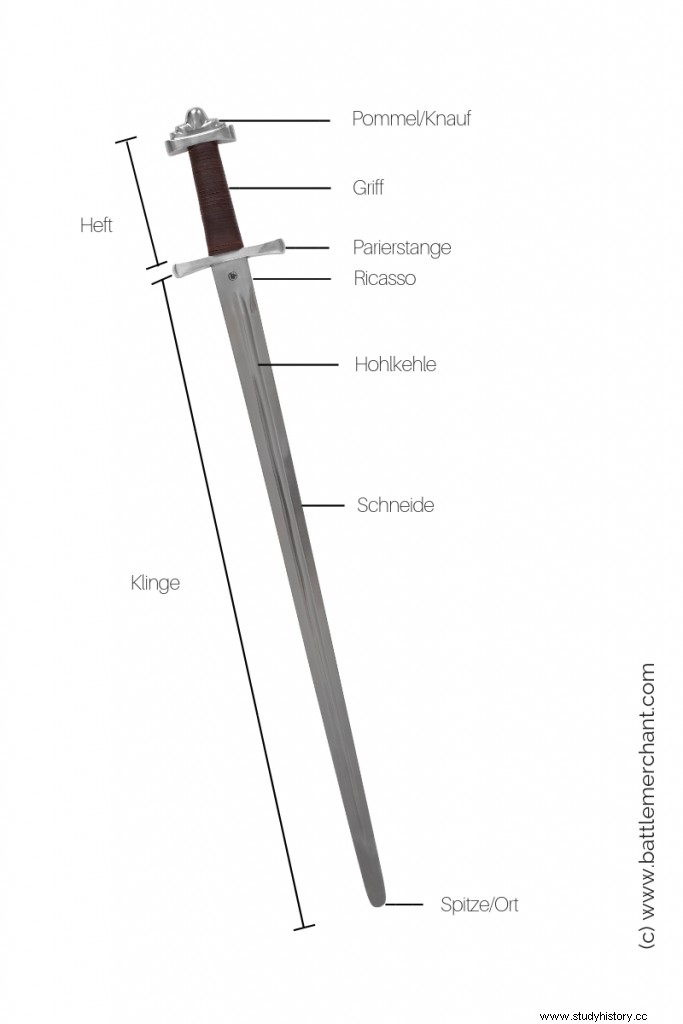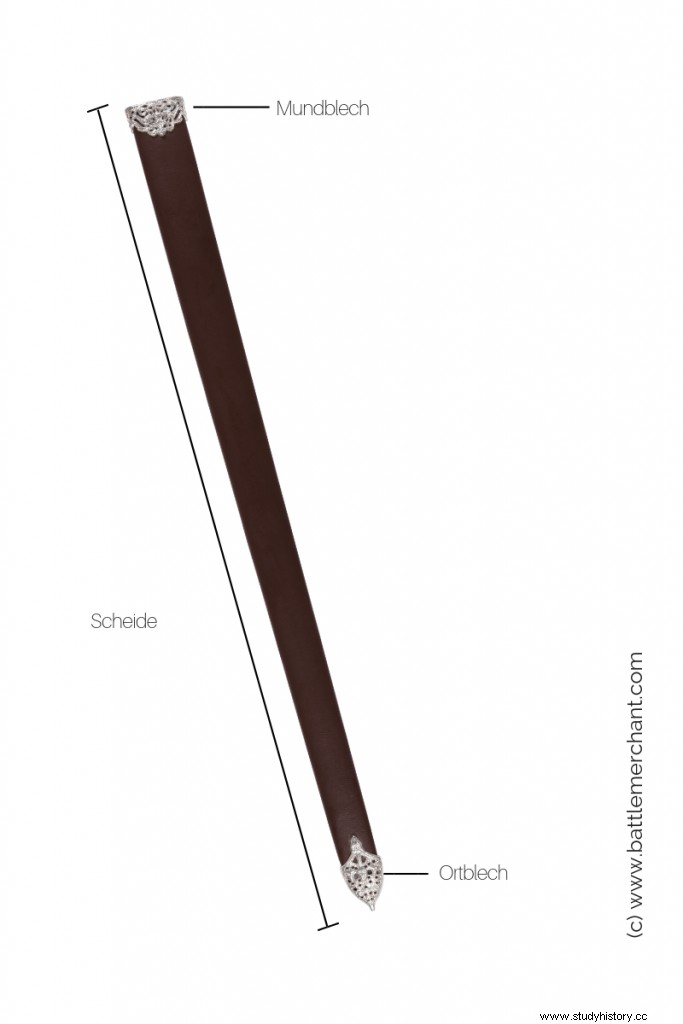Although swords vary greatly in their handling and many different sword shapes have evolved since the first swords of the Bronze Age, most are based on a similar construction. In this article we present the individual components of the sword and their functions.
Blade and tang

A blade consists of the tang and the blade.
The Angle, also known as the tang, is an important part of the sword that is often underestimated. Because it connects the hilt with the blade and has to endure a lot in battle. The tang is therefore not visible and can be described as a long spike at the end of the blade that runs through the handle and crossguard and is riveted, beaten flat or bent at the pommel.
The blade already has its outer shape after it has been forged. The straight side edges, which are slightly inclined towards each other, curve to a point. The cross-section of the blade often has the shape of a rhombus. The ridge that runs down the middle of the sheet is called the ridge.
Quellier, grip and pommel
The booklet A sword consists of the hilt, the pommel and a crossguard. The historical term for heft is Hilz.
The knob , also known as pommel, protects the warrior from the sword slipping out of his hand and regulates the center of gravity of the sword with its weight. It therefore forms a counterweight to the blade and prevents the sword from becoming top-heavy.
The elongated guard, is located between the handle and the blade alsocrossbar called. It protects the hand from hits by the opponent and from slipping. In addition to the quillons, there are other types of quillons:quillons, quillons or quillons. Many different shapes and combinations can be found since the advent of the rapier in the 16th century.
The tang is also mounted on the handle. Wooden handles were often burned onto the hot rod. Some swords have hilts made out of two scales joined together on the tang.
Cut, place and ricasso - the work of the sword sweeper
In the early Middle Ages, the blacksmith completed his work himself by grinding the forged blade to size. In the late Middle Ages, when swords became mass-produced, this craft was taken over by sword sweepers. When sweeping a sword, the cutting edge and locus are ground and the blade is polished.
The cutting edge sharpens the sword. It is therefore also referred to as sharpness. Opposite the cutting edge is the spine or a second cutting edge, also called the short cutting edge. In the last case, a double-edged sword was made. The cutting edge can also be divided into strength and weakness. Thickness is the part between the hilt and the center of the blade. Weakness, therefore, the part between the place and the middle of the blade. The terms are explained by the respective leverage effect:this is stronger in the direction of the magazine than in the direction of location.
The Ricasso is the blunt part of the blade that is directly adjacent to the hilt. Especially with powerful swords like the bastard sword or the two-handed sword, this has the advantage that the warrior can grip the sword further forward. This gives him better control of his sword in certain situations.
The place is the tip of the blade blade. On many swords, the cutting edge begins at a greater distance from the end of the blade. Some swords were fullered. These long grooves stabilize the blade and make it lighter. They are sometimes called blood gutters out of ignorance.
The scabbard - For safe storage of your swords
 The scabbard is used to store the sword and protect it during transport. The top of the scabbard is held by a chain strengthened. A reinforcement at the opening of the scabbard is the mouth plate . Eyelets are often attached to the locket, with which the sword can be attached to the belt.
The scabbard is used to store the sword and protect it during transport. The top of the scabbard is held by a chain strengthened. A reinforcement at the opening of the scabbard is the mouth plate . Eyelets are often attached to the locket, with which the sword can be attached to the belt.
Sharp medieval sword vs. battle sword
The sword is used in film scenes, in re-enactments and in exhibition fights. Show fight swords are very detailed replicas of finds of real medieval swords. They differ, however, in the missing cutting edge and the rounded location. These barely noticeable differences allow the performer to return unscathed from the battle with the exhibition sword.
For exhibition combat, it has proven useful to classify swords according to their suitability and quality. We at Battle-Merchant have therefore divided our swords into three exhibition combat classes:SK-A, SK-B and SK-C. The most important criterion is the hardness of the blade. The greater the degree of hardness, the more the sword can withstand and the lower the risk of nicks.
You can find the exact guidelines for our classification on our information page on the subject of sword fighting.
